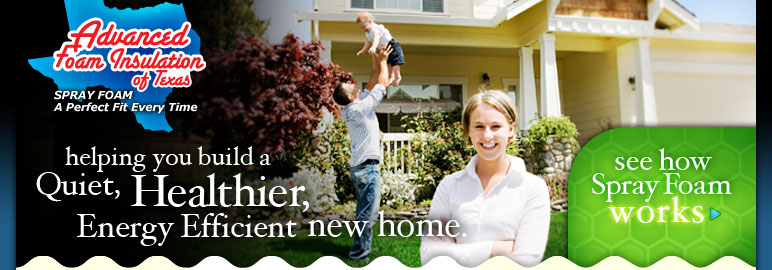is a foamed plastic material, formed by combining two components, isocyanate and a resin, to form a semi-rigid to rigid, fully adhered, air-resistant, water-resistant, insulating material. When used in a residential or commercial environment, SPF bonds well to most substrate materials including concrete, metal, wood, drywall, plaster and others. It is a great insulation for sealing your home from air and moisture intrusion, reducing utility cost by up to 60%, providing noise reduction, and improving indoor air quality.







Creating an air barrier using Foam Insulation can reduce your energy cost 30% to 50% by eliminating air leakage. Many people believe that R-Value is the key to energy consumption. Unfornately, R-Value does not factor in air leakage, the #1 source for energy loss.
Improving the indoor air quality is a key factor for many home buyers, especially those suffering from allergies, asthma, or other respiratory ploblems. Sealing the envelope of a house, random air leakages are eliminated and penetrations of dust, allergens, pollens and other polutants are significantly reduced. This also allows you to design your heating and cooling equipment to maximize air quaility. Humidity is better controlled so that you can eliminate health issues such as mold and mildew.
Spray Polyurethane Foam is inert. It does not settle, shrink,sag, turn into dust or decline in R-value over time. It offers no food value to bacteria, termites, insects or rodents.
Foam has a significant effect on airbourne noises. It can also be used for soundproofing interior walls, plumbing stacks to resuce the sound of rushing water.
back up to topics
Cured polyurethane foam is NOT toxic. However, when the foam is being applied we are basically making a plastic and thus, there are hazardous chemicals involved. Within a half hour of application and with proper ventilation there are no hazardous fumes present in the building. After curing it is an inert plastic that will last hundreds of years.
back up to topics
No, Spray Polyurethane Foam is not a fire hazard. About 15% of its components are fire retardants. Its flame spread and smoke developed index are less than 25 and 450, respectively, which are the magic numbers for building code acceptance. If you were to try to light Spray Polyurethane Foam on fire it would simply melt and char. Once you took the flame source away it would self-extinguish. The toxins given off when Spray Polyurethane Foam burns are less than those given off by burning wood.
back up to topics
R-Value is one of the most misused and misunderstood measurements in the world. The test results are determined in a 75-degree (F) lab with no wind load and ideal humidity. In such conditions the two insulation types are identical with respect to heat transfer. However, once the insulation is installed in a home in real world conditions, the heat loss/gain of fiberglass and cellulose are outrageous since cold and warm air move freely about them through convection. Spray Polyurethane Foam is an air barrier AND it is physically adhered to the wood framing members of a structure thus minimizing air infiltration. Think of fiberglass as a screen and Spray Polyurethane Foam as a window. Coincidentally, most furnace filters are made from fiberglass. These filters are obviously designed to allow the free movement of air through them.
back up to topics
One has to look at the complete cost of something they are putting into their house before making a decision. The cost of insulation is small compared to the ongoing heating and cooling costs of your home after you move in. Since your energy use is cut in half with Spray Polyurethane Foam anyone can do the math and realize that after about five years the cost of insulation, heating fuel, and electricity for cooling is the same for both Spray Polyurethane Foam foam and fiberglass. After that time your energy savings with Spray Polyurethane Foam will put cash in your pocket every year.
back up to topics
Yes it can, but it’s highly unlikely, especially in the windy climates of the northeastern United States. Wood framed homes will always have some small gaps and cracks no matter how well they are framed or insulated. Windows will also have small amounts of air infiltration. Whenever a door is opened to the outside of the home air exchange occurs. Our position is that you only get one chance to insulate a new home. If you under-insulate you will regret it. In the unlikely event that you over-insulate the situation can be remedied with low cost ventilation.
back up to topics
Any foam such as Spray Polyurethane Foam that adheres to building materials, must remain flexible in order to maintain its air seal. Buildings expand and contract with changes of season and temperature. If the foam is too rigid, it will inevitably develop cracks along the studs and ultimately the air seal will be destroyed. While other types of non-rigid insulation — such as batts and loose fill cellulose — can slip, sag, or settle, leaving un-insulated gaps.
back up to topics
No. It is non-corrosive, neutral — neither acidic nor alkaline — and ideal for metal construction.
back up to topics
No. Attic and roof venting were developed because of the inferiority of non-foam insulation. In the winter in northern climates, moisture typically condenses on the interior side of insulation because the interior wall temperatures are relatively cold compared to the warmer air toward the center of the house. The only way to get the moisture out of the house was the creation of ridge and soffit venting. Unfortunately, this also results in the loss of heat. In the summer, venting is typically used to remove warm air from un-insulated attic spaces, one of the purposes of which is to protect the underside of roof shingles from excessive heat. With Spray Polyurethane Foam there are no such problems. The temperature of rooms in the winter is uniform throughout, thus eliminating any chance for condensation to occur. In the summer, the attic is just slightly warmer than the rest of the house, thus there is no potential for roof shingle damage.

